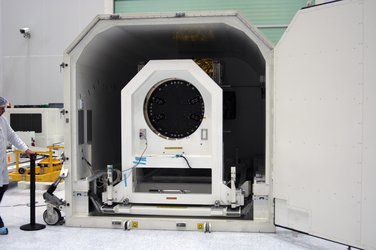GIOVE-B on the launch pad
The launcher that will carry GIOVE-B into orbit has been moved from the final assembly building to the launch pad in preparation for liftoff on Sunday morning.
Shortly after sunrise this Tuesday morning in Baikonur, a Soyuz launcher with the

A more than classic image: these operations have been performed this way for over 50 years, since the launch of Sputnik, the first satellite sent into orbit, and of Yuri Gagarin, the first man in space.
A traditional vision but still very moving, illustrating the activity on this historical 'cosmodrome' which, after the race for space during the cold war, has been progressively opening itself up and is now able to be used for a programme such as Galileo - with this second launch by Soyuz following on from

The Soyuz operations are well known, since there have been close to 1800 launches. This does not prevent engineers and technicians, from Europe but also from the launch facility, from rushing to make pictures in front of 'their' rocket. Some even have tears in their eyes while watching the train arriving at the pad and the rocket being raised to the vertical, ready to race into the cosmos.
The Soyuz machine worked like a Swiss clock, and in two hours the train could return to the assembly building, leaving Soyuz on its pad. The launcher is surrounded by its servicing tower, whose petals will now re-open half an hour before the lift off at 04:16 Sunday morning in Baikonur - sixteen minutes after midnight for Europe.

At the launch zone it is now time for the final preparations, in particular the holding of a general rehearsal on Thursday. Fueling of the launcher will be carried out on Saturday - a task that will be authorised less than five hours before lift off.
Thus, a decisive step is coming for this second Galileo satellite,















 Germany
Germany
 Austria
Austria
 Belgium
Belgium
 Denmark
Denmark
 Spain
Spain
 Estonia
Estonia
 Finland
Finland
 France
France
 Greece
Greece
 Hungary
Hungary
 Ireland
Ireland
 Italy
Italy
 Luxembourg
Luxembourg
 Norway
Norway
 The Netherlands
The Netherlands
 Poland
Poland
 Portugal
Portugal
 Czechia
Czechia
 Romania
Romania
 United Kingdom
United Kingdom
 Slovenia
Slovenia
 Sweden
Sweden
 Switzerland
Switzerland

































